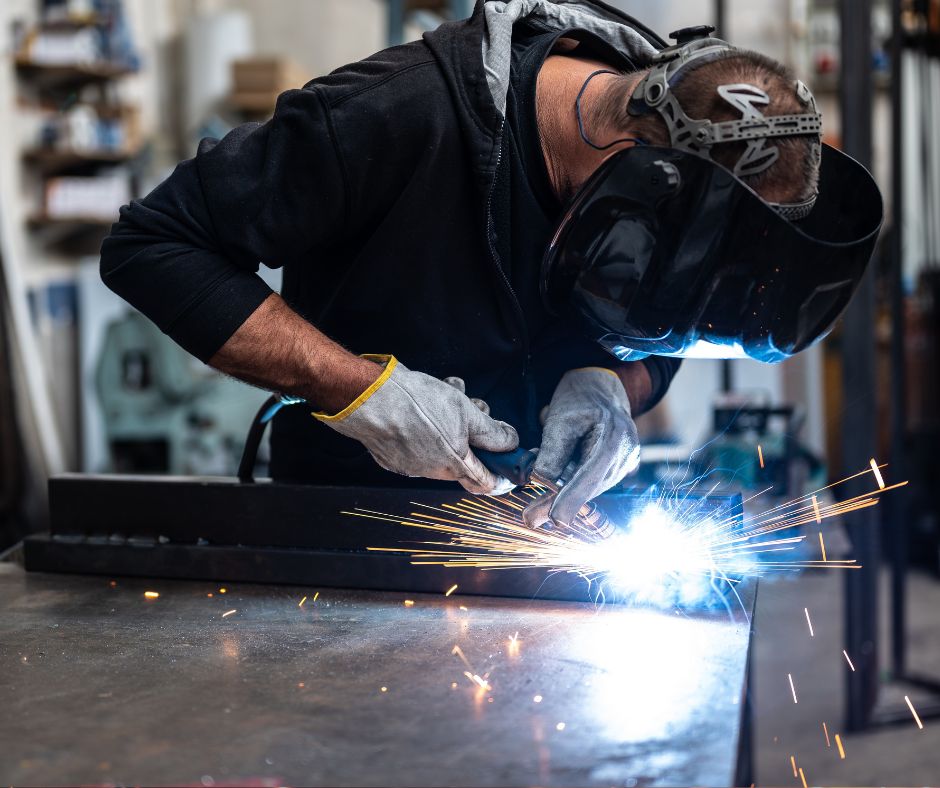Welding can open the door to a rewarding hands-on career or an exciting hobby that lets you build, repair, and create with metal. Before you start melting steel, you must understand the welding tools involved. From safety gear to machines, every piece of equipment serves an essential purpose.
If you’re just starting, Stratford Career Institute offers an affordable and convenient Welding Training course to help you learn the welding essentials. Stratford’s course can be a helpful first step in deciding whether welding is the right path for you.
Let’s take a closer look at a welding equipment list.
Basic Welding Tools Every Welder Should Have
Welding requires specific tools to ensure safety, accuracy, and good results. Here’s a breakdown of welding tools and equipment.
1. Welding Machine (Welder)
Your welding machine is the primary tool you’ll use. It produces the electrical current necessary to create an arc hot enough to melt and fuse metal. Different welding machines (MIG, TIG, or Stick) are built for different techniques.
Choosing the right welder will depend on the type of welding you want and the materials you’re working with.
2. Welding Helmet
A welding helmet protects your eyes and face from the intense light and heat created during welding. It also shields you from sparks, debris, and UV radiation.
This equipment is one of the most essential pieces of equipment on this welding tools list. Welding without proper protection can lead to injury and damage.
3. Protective Gear
Welding produces high heat, sparks, and molten metal, so wearing protective welding accessories is imperative. Essential items include:
- Welding gloves,
- Welding jacket or apron, and
- Steel-toe boots.
These items work together to reduce your risk of burns or serious injury.
4. Welding Clamps
Welding clamps help hold your metal pieces in place so you can create straight, strong welds. They’re useful whether you’re tacking parts together or doing a full pass. Your pieces can shift during welding without clamps, leading to weak joints or misalignment.
5. Chipping Hammer and Wire Brush
After completing a weld, slag forms on the surface. A chipping hammer helps knock that slag off, while a wire brush smooths and cleans the area.
These tools are essential for both safety and quality. Cleaning the weld allows for better inspection and stronger results if you plan to layer multiple passes.
6. Angle Grinder
An angle grinder is one of your kit’s most versatile tools for welding. You can use it to clean metal before welding and smooth rough welds afterward.
Grinders can be loud and dusty, so always wear eye and hearing protection. Once you get comfortable with the tool, it becomes a go-to piece of equipment for most metalwork.
7. Welding Table
A welding table provides a flat, heat-resistant, and grounded surface to work on. Many are made of steel and come with features like built-in clamps, slots, and shelves. Some even have adjustable heights or wheels for mobility.
8. Measuring and Marking Tools
Precision matters in welding. Tape measures, metal rulers, soapstone markers, squares, and levels help you prepare accurate cuts and alignments before starting your weld. Soapstone is commonly used because it marks metal clearly and doesn’t burn away during welding.
9. Fume Extractor or Ventilation Fan
Welding fumes can be hazardous, especially in enclosed spaces. A fume extractor pulls fumes away from your face and filters them, helping maintain safe air quality. At the very least, a strong ventilation fan can help move air through your work area.
How to Choose the Right Welding Tools
If you’re new to welding, your welding tools don’t have to be complicated or expensive. Start with the essentials, like a beginner-friendly welder, basic PPE, and a few hand tools. You might find it helpful to buy a starter welding kit, which often includes a helmet, gloves, clamps, and other basic accessories.
You can upgrade specific tools or add new ones as your projects become more advanced.
Build Your Welding Knowledge from the Ground Up
Welding is a practical skill that starts with understanding the tools and grows through practice and education. The tools in your kit make all the difference in your safety, efficiency, and results.
If you’re interested in learning more, Stratford Career Institute offers an introductory Welding Training course you can complete at home on your schedule. It’s a way to explore welding basics, tools, and techniques, without committing to a trade school or certification program.
Ready to spark your interest in welding? Visit Stratford Career Institute to learn more.


